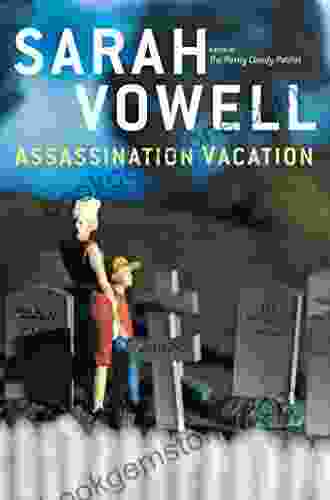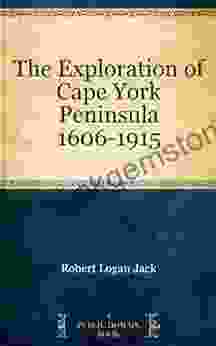Exploring the Untamed: A Journey Through Cape York Peninsula, 1606-1915

Cape York Peninsula, the northernmost point of mainland Australia, is a vast and rugged land of towering rainforests, ancient Indigenous cultures, and a fascinating exploration history. From the arrival of the first European explorers in the early 17th century to the establishment of mission stations and the construction of the Overland Telegraph Line in the 19th century, the peninsula has been the scene of numerous expeditions and adventures.
This article provides an overview of the exploration of Cape York Peninsula between 1606 and 1915, focusing on key expeditions, their leaders, and the challenges and discoveries they faced. It also highlights the role of Indigenous peoples in the peninsula's history and the impact of exploration on the region's environment and culture.
4 out of 5
| Language | : | English |
| File size | : | 195 KB |
| Text-to-Speech | : | Enabled |
| Screen Reader | : | Supported |
| Enhanced typesetting | : | Enabled |
| Word Wise | : | Enabled |
| Print length | : | 150 pages |
| Lending | : | Enabled |
Early European Exploration: 1606-1770
The first Europeans to explore Cape York Peninsula were Dutch navigators who arrived in the region in 1606. They named the peninsula "Cape Keerweer" (Cape Turn Back) due to the treacherous currents and hostile waters they encountered.
In 1770, Captain James Cook sailed along the east coast of the peninsula and named it "Cape York" after the Duke of York. Cook's expedition encountered Indigenous peoples, who were described as tall, well-proportioned, and armed with spears and shields.
William Bligh's Exploration: 1792
In 1792, Captain William Bligh, known for his disastrous voyage aboard the HMS Bounty, explored the west coast of Cape York Peninsula. He charted the coastline, collected botanical specimens, and encountered numerous Indigenous groups.
Bligh's expedition faced challenges due to the rugged terrain and frequent attacks by Indigenous people. Despite these difficulties, he provided valuable information about the peninsula's geography and resources.
Edward Kennedy's Explorations: 1848-1852
Edward Kennedy led several expeditions into Cape York Peninsula between 1848 and 1852. He was the first European to explore the interior of the peninsula and his expeditions provided important geographical knowledge of the region.
Kennedy's expeditions also encountered Indigenous peoples, who were often hostile. In 1848, Kennedy was attacked by a group of Indigenous people and was forced to retreat. However, he returned to the peninsula in 1852 and successfully crossed the Great Dividing Range.
Overland Telegraph Line: 1869-1872
The construction of the Overland Telegraph Line between 1869 and 1872 was a significant event in the exploration and development of Cape York Peninsula. The line, which connected Darwin to Adelaide, required the establishment of repeater stations and telegraph stations along the peninsula's coastline.
The construction of the telegraph line involved significant challenges, including the rugged terrain, harsh climate, and hostile Indigenous groups. However, the telegraph line opened up the peninsula to further exploration and settlement.
Missionary Settlement: 1874-1915
The late 19th and early 20th centuries saw the establishment of mission stations on Cape York Peninsula, led by various Christian denominations. These missions aimed to convert Indigenous peoples to Christianity and introduce Western education and culture.
Missionaries played a complex and often controversial role in the history of the peninsula. They provided healthcare and education to Indigenous communities, but they also disrupted traditional Indigenous cultures and practices.
Laura River Massacre: 1897
One of the darkest chapters in the history of Cape York Peninsula is the Laura River Massacre of 1897. Police and settlers killed an unknown number of Indigenous people, including women and children, in retaliation for the killing of two white settlers.
The Laura River Massacre left a lasting scar on the relationship between Indigenous peoples and non-Indigenous settlers on Cape York Peninsula.
Ernest Favenc's Exploration: 1882-1885
Ernest Favenc led several expeditions into the interior of Cape York Peninsula between 1882 and 1885. He was the first European to explore the Cape York and Mitchell River area and his expeditions collected valuable scientific data about the region's flora and fauna.
Favenc's expeditions also encountered conflicts with Indigenous peoples. In 1883, he was attacked by a group of Indigenous people, resulting in the death of one of his companions.
Thomas Boyd's Exploration: 1890-1891
Thomas Boyd explored the west coast of Cape York Peninsula in 1890-1891. He charted the coastline, explored the Mitchell River, and encountered various Indigenous groups.
Boyd's expedition experienced harsh conditions and encounters with hostile Indigenous peoples. He was forced to abandon his expedition due to lack of supplies and the threat of attack.
Joseph Byrne's Exploration: 1897
Joseph Byrne explored the Coen Peninsula and Palm Island in 1897. He collected valuable information about the geology and resources of the region.
Byrne's expedition also encountered Indigenous peoples, who were described as shy but peaceful. He provided valuable insights into the Indigenous cultures and traditions of Cape York Peninsula.
Horn Expedition: 1897-1898
The Horn Expedition, led by Dr. Cecil Cairns, explored the Mitchell River and Coen Peninsula in 1897-1898. The expedition collected extensive scientific data and provided valuable information about the region's geology, flora, and fauna.
The Horn Expedition also encountered Indigenous peoples, who were described as friendly and cooperative. The expedition's interactions with Indigenous peoples illustrate the complex and varied relationships between Indigenous and non-Indigenous peoples in Cape York Peninsula.
Queensland Government Exploration: 1899-1915
The Queensland Government conducted several expeditions into Cape York Peninsula from 1899 to 1915. These expeditions aimed to explore the interior of the peninsula, assess its resources, and establish settlements.
The Queensland Government expeditions encountered various Indigenous groups, who were sometimes hostile and sometimes receptive. The expeditions also provided valuable information about the peninsula's geography, climate, and agricultural potential.
Indigenous Peoples of Cape York Peninsula
The Indigenous peoples of Cape York Peninsula have inhabited the region for thousands of years. They have a rich and diverse culture, with complex social structures and spiritual beliefs.
The Indigenous peoples of Cape York Peninsula have played a vital role in the exploration and development of the region. They provided food, water, and guidance to explorers, and they shared their knowledge of the land and its resources.
However, the exploration and settlement of Cape York Peninsula also had a profound impact on Indigenous peoples. They were displaced from their traditional lands, their cultures were disrupted, and they were subjected to violence and exploitation.
The exploration of Cape York Peninsula between 1606 and 1915 was a complex and fascinating period in the history of Australia. It was a time of discovery, adventure, and tragedy. It was also a time of conflict and cooperation between
4 out of 5
| Language | : | English |
| File size | : | 195 KB |
| Text-to-Speech | : | Enabled |
| Screen Reader | : | Supported |
| Enhanced typesetting | : | Enabled |
| Word Wise | : | Enabled |
| Print length | : | 150 pages |
| Lending | : | Enabled |
Do you want to contribute by writing guest posts on this blog?
Please contact us and send us a resume of previous articles that you have written.
 Best Book
Best Book Page Flip
Page Flip Bookshelf
Bookshelf Literary loom
Literary loom Chapter
Chapter Bookish
Bookish PageTurner
PageTurner Bibliophile
Bibliophile Story
Story Inkwell
Inkwell Bookworm
Bookworm Labyrinth
Labyrinth Plot Twist
Plot Twist Prose
Prose Paperback
Paperback Storyteller
Storyteller Sanctuary
Sanctuary Fiction
Fiction Reading
Reading Chronicle
Chronicle Read
Read Sophie Fuggle
Sophie Fuggle Joel J Lerner
Joel J Lerner Jason Dean
Jason Dean Chic Scott
Chic Scott Supersummary
Supersummary Laura Lee Smith
Laura Lee Smith Sara Wheeler
Sara Wheeler Dan Fullerton
Dan Fullerton Various
Various Amy Wilentz
Amy Wilentz Konstantinos Mylonas
Konstantinos Mylonas W M Raebeck
W M Raebeck Shay Spivey
Shay Spivey Robert Cargill
Robert Cargill Educational Testing Service
Educational Testing Service Sharon A Wynne
Sharon A Wynne John Gilstrap
John Gilstrap Robert Finch
Robert Finch 50minutes Com
50minutes Com Mark Dawson
Mark Dawson Morgan Stafford
Morgan Stafford Julia Alvarez
Julia Alvarez Elizabeth Hay
Elizabeth Hay Rosita Forbes
Rosita Forbes Jesse M Ehrenfeld
Jesse M Ehrenfeld Maria Spantidi
Maria Spantidi Gina Wisker
Gina Wisker Juliet Grames
Juliet Grames Eugene C Toy
Eugene C Toy Dr Ray Makar
Dr Ray Makar Aminta Arrington
Aminta Arrington Nick Angelis
Nick Angelis Nick Smith
Nick Smith April Vahle Hamel
April Vahle Hamel Ingrid P Wicken
Ingrid P Wicken Richard Henry Dana
Richard Henry Dana Dr Hooelz
Dr Hooelz Maggie Ryan
Maggie Ryan Stuart Woods
Stuart Woods Insight Guides
Insight Guides John Hiker
John Hiker Jearl Walker
Jearl Walker Matt Racine
Matt Racine Khaled Hosseini
Khaled Hosseini Patrick O Sullivan
Patrick O Sullivan Rebecca E F Barone
Rebecca E F Barone Jim Mancuso
Jim Mancuso Tim Brown
Tim Brown Ian C Friedman
Ian C Friedman Garry J Shaw
Garry J Shaw Kristin Hannah
Kristin Hannah Fred Ray Lybrand
Fred Ray Lybrand Sigurd F Olson
Sigurd F Olson Kaplan Test Prep
Kaplan Test Prep Greg Gilhooly
Greg Gilhooly Zip Reads
Zip Reads Triumphant Test Prep
Triumphant Test Prep Edward R Lachapelle
Edward R Lachapelle Greg Breining
Greg Breining Katrina Lawrence
Katrina Lawrence Rochelle Knight
Rochelle Knight Kim Heinbuch
Kim Heinbuch Huma Filo
Huma Filo Leo Books
Leo Books Kristine Ellingson
Kristine Ellingson Edna Fernandes
Edna Fernandes Zigzag English
Zigzag English T A Williams
T A Williams Print Replica Kindle Edition
Print Replica Kindle Edition John Morrison
John Morrison Erin Trahan
Erin Trahan Seth Abramson
Seth Abramson Robert D Kaplan
Robert D Kaplan J D Ware
J D Ware Jane Bottomley
Jane Bottomley Richard Kadrey
Richard Kadrey Joe Pelletier
Joe Pelletier Mark Lee
Mark Lee Ben Tall
Ben Tall Cyndi Kinney
Cyndi Kinney Manfred Theisen
Manfred Theisen Paul Murton
Paul Murton Julia Quinn
Julia Quinn Miles Martin
Miles Martin Joseph Robertia
Joseph Robertia Richard Palmer
Richard Palmer John Merriam
John Merriam Ilona Andrews
Ilona Andrews Ben Malisow
Ben Malisow A R Vasishtha
A R Vasishtha Steven Cowie
Steven Cowie Joshua Jelly Schapiro
Joshua Jelly Schapiro Ken Griffey Jr
Ken Griffey Jr Jay H Lefkowitch
Jay H Lefkowitch Gerald Hausman
Gerald Hausman Doug Gaskill
Doug Gaskill Peter Mansfield
Peter Mansfield Balazs Csigi
Balazs Csigi Philip Donlay
Philip Donlay Quick Reads
Quick Reads Sterling Test Prep
Sterling Test Prep Kerry Karram
Kerry Karram Snap Summaries
Snap Summaries Douglas Preston
Douglas Preston Jamie Jensen
Jamie Jensen Pamela K Lamb
Pamela K Lamb Cindi Myers
Cindi Myers Edward Hoagland
Edward Hoagland Wizer
Wizer Sarah Vowell
Sarah Vowell Lewis Morris
Lewis Morris Andy Russell
Andy Russell Um A Yube
Um A Yube Illustrated Edition Kindle Edition
Illustrated Edition Kindle Edition Matthew Simon
Matthew Simon Kanchan Suyash
Kanchan Suyash Bob Duff
Bob Duff Luisa Gastambide
Luisa Gastambide Edwyn Forest
Edwyn Forest Emily Colin
Emily Colin Michele Shriver
Michele Shriver Lynda Field
Lynda Field Sean Dietrich
Sean Dietrich John Hemming
John Hemming Michael Renshaw
Michael Renshaw Martin Woodward
Martin Woodward Andrew Hudgins
Andrew Hudgins Smart Reads
Smart Reads Meike Winnemuth
Meike Winnemuth Gil Martin
Gil Martin John Walters
John Walters Wickaninnish Inn
Wickaninnish Inn Dr John Hockey
Dr John Hockey Andrew Hempstead
Andrew Hempstead Eric Engle
Eric Engle Simon Hart
Simon Hart Stephen Haddelsey
Stephen Haddelsey Markes E Johnson
Markes E Johnson Alexis Lipsitz Flippin
Alexis Lipsitz Flippin Lesley Jane Eales Reynolds
Lesley Jane Eales Reynolds Wolfgang Daunicht
Wolfgang Daunicht Tao Le
Tao Le J R Klein
J R Klein Kindle Edition
Kindle Edition Noor De Olinad
Noor De Olinad Joeanna Rebello Fernandes
Joeanna Rebello Fernandes David Archer
David Archer Cliff Seruntine
Cliff Seruntine Sport Hour
Sport Hour Michael Vlessides
Michael Vlessides Con Coughlin
Con Coughlin Grace Barrington Shaw
Grace Barrington Shaw Janice K Ledford
Janice K Ledford Mike Kraus
Mike Kraus Alina Adams
Alina Adams Zanna Sloniowska
Zanna Sloniowska Paul Johnson
Paul Johnson Christine Wilcox
Christine Wilcox Hugh Sinclair
Hugh Sinclair Rajani Katta
Rajani Katta Wilfred M Mcclay
Wilfred M Mcclay Laura Ben David
Laura Ben David John Henderson
John Henderson Robert N Rosen
Robert N Rosen Vincent Chidindu Asogwa
Vincent Chidindu Asogwa Eric Newman
Eric Newman Kenneth Oppel
Kenneth Oppel Proprietary Edition Kindle Edition
Proprietary Edition Kindle Edition Smart Edition
Smart Edition Helen Wenley
Helen Wenley Lonely Planet
Lonely Planet Mary Ann Hogan
Mary Ann Hogan Joseph Phillips
Joseph Phillips Jenny Mackay
Jenny Mackay Fatime Losonci
Fatime Losonci Khalid Khashoggi
Khalid Khashoggi Jeanie Buss
Jeanie Buss James Cowan
James Cowan Mauricio Fau
Mauricio Fau Deanna Raybourn
Deanna Raybourn Rusty Young
Rusty Young Alex Hibbert
Alex Hibbert Hannah Tyson
Hannah Tyson Gavin Francis
Gavin Francis Helene St James
Helene St James Lucy Peet
Lucy Peet Kim Heldman
Kim Heldman Approach Guides
Approach Guides Georgios Papadakis
Georgios Papadakis Michael Corayer
Michael Corayer Janet Evans
Janet Evans Felicie Williams
Felicie Williams Robert Collins
Robert Collins Brien Foerster
Brien Foerster Nielson Phu
Nielson Phu G Neri
G Neri Osasumwen Asoro
Osasumwen Asoro Susan Weese
Susan Weese Rebecca Hill
Rebecca Hill Russell Maddicks
Russell Maddicks Jen Beck Seymour
Jen Beck Seymour Lucy Coleman
Lucy Coleman William Ma
William Ma Lisa Kleypas
Lisa Kleypas Randy Wayne White
Randy Wayne White General
General Caryn Boddie
Caryn Boddie Steven W Dulan
Steven W Dulan George Orwell
George Orwell William W Johnstone
William W Johnstone Redhen Family
Redhen Family Dr Lew Deitch
Dr Lew Deitch Stephen Ausherman
Stephen Ausherman Brian Mcfarlane
Brian Mcfarlane Michael Powell
Michael Powell Rich Polanco
Rich Polanco Nicholas Crowder
Nicholas Crowder Ashley Schmitt
Ashley Schmitt Richard Bak
Richard Bak Dixie Dansercoer
Dixie Dansercoer John Murray
John Murray Pat Thomson
Pat Thomson Kayla Chalko
Kayla Chalko Angela Stevens
Angela Stevens Bob Smale
Bob Smale J R Haseloff
J R Haseloff Simon Richmond
Simon Richmond Tessa Dare
Tessa Dare Philip Jackson
Philip Jackson Ron Siliko
Ron Siliko Kira Salak
Kira Salak Tony Horwitz
Tony Horwitz William Wadsworth
William Wadsworth Kate Williams
Kate Williams Justin Goldman
Justin Goldman Christophe P Yerling Ph D
Christophe P Yerling Ph D Brandon Royal
Brandon Royal Savage Greenboro
Savage Greenboro Bob Shepton
Bob Shepton Nicholas Bjorn
Nicholas Bjorn Businessnews Publishing
Businessnews Publishing Julian Stern
Julian Stern Helene Martensson
Helene Martensson Peterson S
Peterson S Luca Brambilla
Luca Brambilla Francis J Buckley
Francis J Buckley Rod Kulbach
Rod Kulbach Hilde Hoogenboom
Hilde Hoogenboom Raquel Baccetto
Raquel Baccetto Thomas E Johnson
Thomas E Johnson Laura Lincoln Maitland
Laura Lincoln Maitland Mitt Romney
Mitt Romney Nigel Cliff
Nigel Cliff L T Ryan
L T Ryan Narendra Kumar V
Narendra Kumar V Evie Litton
Evie Litton Helen Dunn Frame
Helen Dunn Frame Kevin Shea
Kevin Shea Melody Carlson
Melody Carlson John Keahey
John Keahey Luca Vargiu
Luca Vargiu Ian Tuhovsky
Ian Tuhovsky Brooks Fiesinger
Brooks Fiesinger Prasad Raju V V N R Pathapati
Prasad Raju V V N R Pathapati Darren Alff
Darren Alff Lawrence Durrell
Lawrence Durrell Jocelyn Jane Cox
Jocelyn Jane Cox Fiona Gibson
Fiona Gibson Rob Pate
Rob Pate Lucille Recht Penner
Lucille Recht Penner Lonely Planet Kids
Lonely Planet Kids Tony Daffern
Tony Daffern Lloyd Richardson
Lloyd Richardson Jack Slater
Jack Slater C E Flores
C E Flores Mariah Laine Moyle
Mariah Laine Moyle Christopher D Nolan
Christopher D Nolan Robert B Parker
Robert B Parker Ted Chiang
Ted Chiang Paul Ames
Paul Ames Jean Vives
Jean Vives Neil Chelton
Neil Chelton Michele G Kunz
Michele G Kunz Ted Kulfan
Ted Kulfan Lance Pototschnik
Lance Pototschnik Nicholas J Cotsonika
Nicholas J Cotsonika Caitlin Doughty
Caitlin Doughty Cosmic Kids Publications
Cosmic Kids Publications Genius Reads
Genius Reads Robert Crais
Robert Crais Stephan Orth
Stephan Orth Monica Sorrenson
Monica Sorrenson Lingo Mastery
Lingo Mastery Garry Burnett
Garry Burnett Gregg Hurwitz
Gregg Hurwitz Douglas J Gould
Douglas J Gould Neha Gupta
Neha Gupta Rupika Raj
Rupika Raj Pauline Harmange
Pauline Harmange Nisha Garg
Nisha Garg Lorelou Desjardins
Lorelou Desjardins John Rae
John Rae Nicholas Gallo
Nicholas Gallo Scott Butler
Scott Butler Mike Chambers
Mike Chambers Rico Austin
Rico Austin Joshua Armstrong
Joshua Armstrong Anuj Tikku
Anuj Tikku Mark Zegarelli
Mark Zegarelli Meghan Mccarthy
Meghan Mccarthy Marie Benedict
Marie Benedict Emily Kimelman
Emily Kimelman Tim Notier
Tim Notier Jeremy K Davis
Jeremy K Davis Mark Rosenman
Mark Rosenman Andy Kirkpatrick
Andy Kirkpatrick Trivium Test Prep
Trivium Test Prep James Cave
James Cave Mark Greaney
Mark Greaney Nikki Nichols
Nikki Nichols Wayne J Lutz
Wayne J Lutz Wendy C Crone
Wendy C Crone Rex Nelson
Rex Nelson Manny Serrato
Manny Serrato Karsten Heuer
Karsten Heuer J Maarten Troost
J Maarten Troost Kevin Biggar
Kevin Biggar Vince Kotchian
Vince Kotchian Jeff Hay
Jeff Hay Ken Chaddock
Ken Chaddock Nick Adams
Nick Adams Lally Brown
Lally Brown Megan Poore
Megan Poore S K Gupta
S K Gupta Len Airey
Len Airey Margaret K Nydell
Margaret K Nydell Russell Streeter
Russell Streeter Hugo Banzer Suarez
Hugo Banzer Suarez Jason Hogan
Jason Hogan Lawrence Osborne
Lawrence Osborne Moshe Ohayon
Moshe Ohayon Rory Stewart
Rory Stewart Eric Bodnar
Eric Bodnar Prepvantage
Prepvantage Skip Hollandsworth
Skip Hollandsworth David J Rothman
David J Rothman R Raman
R Raman Steve Warner
Steve Warner Julia Ann Clayton
Julia Ann Clayton Topher Donahue
Topher Donahue Marie Cirano
Marie Cirano Terry Pratchett
Terry Pratchett Tony Mendoza
Tony Mendoza Jonny Zucker
Jonny Zucker Alan Charlesworth
Alan Charlesworth Nadav Snir
Nadav Snir Viki Winterton
Viki Winterton Baby Professor
Baby Professor Anita Landoll
Anita Landoll Sigrid Fry Revere
Sigrid Fry Revere John W Lundin
John W Lundin Rachel Russ
Rachel Russ Grady Hendrix
Grady Hendrix Ray Walker
Ray Walker Keri Bloomfield
Keri Bloomfield Warwick Trucker
Warwick Trucker Nachole Johnson
Nachole Johnson Disha Experts
Disha Experts Tim Hannigan
Tim Hannigan Kevin Marx
Kevin Marx W E B Griffin
W E B Griffin Rhonda Leeman Taylor
Rhonda Leeman Taylor Hicham And Mohamed Ibnalkadi
Hicham And Mohamed Ibnalkadi Tracy Johnston
Tracy Johnston Wayne Johnston
Wayne Johnston Narasimha Karumanchi
Narasimha Karumanchi William Pitts
William Pitts John Seibert Farnsworth
John Seibert Farnsworth Dr Jyuthica Laghate
Dr Jyuthica Laghate David Gordon
David Gordon C F Crist
C F Crist Janet Chapple
Janet Chapple Rick Steves
Rick Steves Jared Derksen
Jared Derksen Leslie Davenport
Leslie Davenport Laura Albritton
Laura Albritton Sandra Dallas
Sandra Dallas Stephen John
Stephen John Joseph Toone
Joseph Toone John Germov
John Germov Boye Lafayette De Mente
Boye Lafayette De Mente Tim Dowley
Tim Dowley Benjamin P Bowser
Benjamin P Bowser Roy Fisher
Roy Fisher L Waxy Gregoire
L Waxy Gregoire Ibl Press
Ibl Press Michel Roy
Michel Roy Carlos A Caggiani
Carlos A Caggiani Jay Kirk
Jay Kirk Kazim Ali
Kazim Ali Harley Wylde
Harley Wylde Bob Mckenzie
Bob Mckenzie Magnus D Jango
Magnus D Jango Michelle Larkin
Michelle Larkin Ross Blankenship
Ross Blankenship Isee Exam Preparation Experts
Isee Exam Preparation Experts Maria Montessori
Maria Montessori Bookrags Com
Bookrags Com Pip Williams
Pip Williams Katherine Nouri Hughes
Katherine Nouri Hughes One Edition Kindle Edition
One Edition Kindle Edition Bruce Boudreau
Bruce Boudreau Bright Summaries
Bright Summaries Ged Wilmot
Ged Wilmot Sylvain Tesson
Sylvain Tesson Dk
Dk Ross Bonander
Ross Bonander Trevanian
Trevanian Carla Mooney
Carla Mooney Colson Whitehead
Colson Whitehead Jeffrey Alford
Jeffrey Alford Terry Frei
Terry Frei Kathleen Norris
Kathleen Norris Jon A Archambault
Jon A Archambault John Scherber
John Scherber Steve Schwartz
Steve Schwartz Nicolas Rodak
Nicolas Rodak John Howells
John Howells Louis L Amour
Louis L Amour Edulink Gmbh
Edulink Gmbh Xavier Marie Bonnot
Xavier Marie Bonnot Paul Watson
Paul Watson Language Guru
Language Guru Saroo Brierley
Saroo Brierley Shanta Kumar
Shanta Kumar Frosty Wooldridge
Frosty Wooldridge Stanley Vast
Stanley Vast Kathleen Kirkland
Kathleen Kirkland Simon Turney
Simon Turney Horace C A
Horace C A Preston George Pysh
Preston George Pysh Tiara R Brown
Tiara R Brown Ana Sortun
Ana Sortun Elena Leman
Elena Leman Fridtjof Nansen
Fridtjof Nansen Mark Mclaughlin
Mark Mclaughlin Tim Bauerschmidt
Tim Bauerschmidt Kristopher Martel
Kristopher Martel Anna Curran
Anna Curran Michelle Lee
Michelle Lee Kaye Edwards
Kaye Edwards Laura Peyton Roberts
Laura Peyton Roberts Elaine Sciolino
Elaine Sciolino Jackson Carter
Jackson Carter Manik Sheoran
Manik Sheoran William Shakespeare
William Shakespeare Bruce Hunt
Bruce Hunt Emt Basic Exam Prep Team
Emt Basic Exam Prep Team Fodor S Travel Guides
Fodor S Travel Guides Jane Moore
Jane Moore United States Government Us Army
United States Government Us Army Tania N Shah
Tania N Shah Seyyed Hossein Nasr
Seyyed Hossein Nasr Yaa Gyasi
Yaa Gyasi Stan Skrabut
Stan Skrabut Fethi Mansouri
Fethi Mansouri Patricia Briggs
Patricia Briggs
Light bulbAdvertise smarter! Our strategic ad space ensures maximum exposure. Reserve your spot today!

 Yukio MishimaThe Philosophers' Guide to Wrestling or The Wrestlers' Guide to Philosophy:...
Yukio MishimaThe Philosophers' Guide to Wrestling or The Wrestlers' Guide to Philosophy:... Cody RussellFollow ·16.5k
Cody RussellFollow ·16.5k Thomas PowellFollow ·3.1k
Thomas PowellFollow ·3.1k Joe SimmonsFollow ·11.3k
Joe SimmonsFollow ·11.3k Ian PowellFollow ·4.4k
Ian PowellFollow ·4.4k Vic ParkerFollow ·4.7k
Vic ParkerFollow ·4.7k Howard PowellFollow ·2.8k
Howard PowellFollow ·2.8k Bob CooperFollow ·4.9k
Bob CooperFollow ·4.9k Jon ReedFollow ·10.5k
Jon ReedFollow ·10.5k

 Scott Parker
Scott ParkerGerman Men Sit Down To Pee And Other Insights Into German...
German culture is...

 Tyler Nelson
Tyler NelsonHigh School: A Comprehensive Guide to Surviving the...
High school can...

 Dan Bell
Dan BellUnlocking Success in Military Careers: A Comprehensive...
Embarking on a military career is a...

 Leslie Carter
Leslie CarterAn American Soldier's Lifelong Journey with Racism: From...
In the annals of...

 Aldous Huxley
Aldous HuxleyFirefighters: Guardians of Our Communities and Exam Study...
Firefighters, the valiant sentinels of...

 Jason Reed
Jason ReedAn Unforgettable Literary Journey: Exploring...
: A Trip Down History's Darkest...
4 out of 5
| Language | : | English |
| File size | : | 195 KB |
| Text-to-Speech | : | Enabled |
| Screen Reader | : | Supported |
| Enhanced typesetting | : | Enabled |
| Word Wise | : | Enabled |
| Print length | : | 150 pages |
| Lending | : | Enabled |










